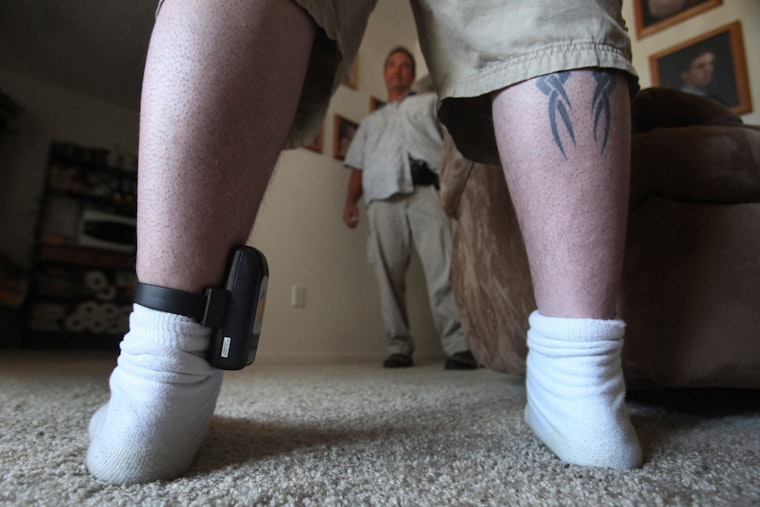Monitoring the Use of Electronic Monitoring
By James Kilgore

One February night in 2009, our phone rang. It was two in the morning. My 95-year-old mother was on the line. She told me she was having chest pains, thought she was having a heart attack, and had already called 911. Since she lived less than a mile away, my immediate response should have been to rush to her side. Instead, I dialed the 1-800 number anyone on parole on an electronic monitoring device is required to call.
The operator picked up after 15 minutes and told me I needed the permission of my parole agent to leave the house. I knew he wouldn’t be available—it was 2:00 a.m., after all—so I faced a difficult choice: go to the hospital and risk getting sent back to prison, or follow the rules and risk my mother passing away without me, after I had already been absent from her life for the six and a half years I was in prison. Fortunately, I had a partner who could go quickly to the hospital. Fortunately, my mother survived.
The next morning, I phoned my parole agent and asked if I could move without permission should such a situation arise again in the future. “It’s a gray area,” he said.
A growing number of people are living in these gray areas. Use of electronic monitoring devices (EM), first introduced in the 1980s, more than doubled between 2005 and 2015, according to research by the Pew Charitable Trusts. The technology has become increasingly popular as the movement to reduce mass incarceration gains momentum. It is touted as a way of bringing down prison populations while still keeping people under the watchful eye of the state.
But electronic monitoring needs to be understood for what it really is: incarceration by another name. And it’s a form of incarceration which has largely arisen without scrutiny or regulation. As Johnny Page, who spent 90 days on the monitor following a 23-and-a-half-year term in an Illinois prison, puts it, “You don’t have to fight for the telephone, you don’t have to fight for the shower—but you’re still in jail.”
Reentry after incarceration is a difficult process. It is exponentially more difficult when you have to go through a formal permission process before making the most elemental moves. Topeka K. Sam, who was on the “ankle shackle” following a prison term in New York, recalls how EM prevented her from getting critical medical tests, like MRIs and scans.
Meanwhile, Father David Kelly, director of the Precious Blood Ministry of Reconciliation on Chicago’s South Side, reports that the restrictions on movement are so onerous that a majority of youth in his highly acclaimed program for helping heal young men and families touched by violence wind up back in detention—not because of any new offenses, but just for violating the EM rules. He even cites cases of youth being put on EM house arrest when they literally don’t have a house.
The surge in the use of these shackles also raises troubling questions about the surveillance state. How secure is the data these devices gather about our neighbors’ comings and goings? Who sees the information, and what are the limits on its use, if any? How long can it be preserved? Where is it stored? And who profits from this system?
It is time, at long last, to try to shine some light on these “gray areas.” I have been working for the past year to help develop guidelines to try to address some of these issues—and safeguard the rights of those on the monitor. I am in good company, working with dozens of advocates and individuals who have lived under EM who are part of a wider effort, the Challenging E-Carceration campaign.
The guidelines have the support of some of the leading criminal justice organizations in the country, including the ACLU, the National Association of Criminal Defense Lawyers, JustLeadershipUSA, the Prison Policy Initiative, and the Pretrial Justice Institute.
We hope to frame the problems those who have lived under this unregulated technology clearly: “Monitoring programs almost universally lack any transparent regulatory framework that respects the human rights of those being monitored and their family or household members.” The guidelines seek to ensure “opportunity, rights, and dignity” by allowing individuals on the monitor to meet “basic daily needs,” from shopping and caregiving to attending religious services.
The guidelines also call for the elimination of the fees charged to those wearing the shackle, which can reach $35 a day and worsen the economic challenges of reentry following incarceration. They further seek to ensure that monitors are not disproportionately used on people of color. And, mindful of the fact that 70 percent of monitors now in use feature GPS capability, they call for regulations to limit who has access to the data, restrict the types of data collected, and set explicit timetables for deleting the data altogether.
This effort does not pretend to fix all the problems associated with electronic monitoring. But as Malikia Cyril, the executive director of the Center for Media Justice and a sponsor of the guidelines, put it, we must acknowledge that EM leads to “less overhead, with more people under the control of courts and community corrections.” The advocates working on these guidelines hope to increase awareness of the costs—financial and human—of this favorite of the surveillance state, and to encourage policymakers to adopt regulations which are safe, effective, and fair.
One day soon, I hope, these gray areas will yield to the light.
James Kilgore is a 2017 Soros Justice Fellow.
James Kilgore is a Soros Justice Fellow and is leading the Challenging E-Carceration Project.

